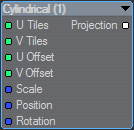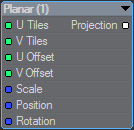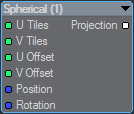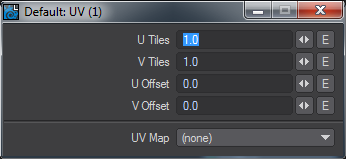Projections
Image Map Projection
Since images are usually rectangular and surfaces may or may not be, you must tell LightWave how you want the image map projected onto the surface. The common projection types settings are Planar, Cylindrical, Spherical, Cubic, Front and UV.
Generally, you should pick the shape that best describes the surface shape. (Note that this is not necessarily the object’s overall shape since that may be made up of many surfaces.) For example, if you were mapping a label image on the sides of a soda can, you’d use Cylindrical. For a planet, you’d use Spherical. For a wall, Planar would do the trick. For a brick, Cubic might be best.
What about a die? Cubic? This may be a trick question. Since a die has a different number of dots on each side, you’d use a different Planar map on each one.
Standard Image Mapping tools (i.e., planar, cylindrical, and spherical mapping) may be somewhat limiting when the surface is irregular in shape. These techniques usually work well only in cases where the entire texture image can be globally mapped using a linear interpolation along two axes. The object geometry essentially has no influence on how the texture is applied.
However, what if you could assign areas of a texture image to points on the surface, essentially tacking it down at key points? This is what UV Mapping in Modeler allows you to do. Between the tacks, the image is stretched smoothly.
The projections nodes are for determining how images are mapped when using the Image Sampler and Normal Sampler nodes.
Cubic
Replicates the Surface Editor Cubic image mapping available in LightWave.
Cylindrical
Replicates the Surface Editor Cylindrical image mapping available in LightWave.
Front
Replicates the Surface Editor Front image mapping available in LightWave.
Planar
Replicates the Surface Editor Planar image mapping available in LightWave.
Spherical
Replicates the Surface Editor Spherical image mapping available in LightWave.
UV
Replicates the Surface Editor UV mapping available in LightWave.
Using projections with Object UVs from Primitive Shapes is not necessary. You can pipe the Image Sampler node with your image directly into the input you want on the surface of a Primitive Shape
Anisotropy requires that there is a Projection node input otherwise you will get strange polygonal shapes in the render.
Left: Anisotropy at 100 %, Rotation at 15 %, Roughness at 30 %. Right: No Projection
UV Tiles and Offsets
In all cases, except Front, Projections include Tiles and Offsets options. These options apply equally to images that are not UV mapped, despite their naming, and simply refer to the horizontal (U) and vertical (V) directions. Using tiles and offsets it is possible to tile image maps over the polygons of a surface. It can also be used as a way of offsetting UDIM tiles.

























